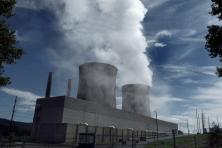Last updated: March 19, 2020
In the wake of the Oregon Legislature's now repeated failure to pass comprehensive statewide climate action, Governor Kate Brown is stepping up to ensure Oregon makes real progress toward addressing the climate crisis. Just days after the latest legislative session ended with no progress, Governor Brown delivered one of the country's strongest Executive Orders on climate - EO 20-04.
Her action reflects a culmination of several years of sustained advocacy by thousands across the state and with the Renew Oregon coalition - including people attending dozens of rallies, delivering hundreds of hours of testimony, offering thousands of volunteer hours, and tens of thousands of emails, letters to the editor, and petitions and making countless calls. The people demanded action and our Governor listened.
Key components of the Executive Order include:
![]() Setting new, stronger goals for cutting climate pollution
Setting new, stronger goals for cutting climate pollution
![]() Directing establishment of regulations and programs to reduce emissions from major sources
Directing establishment of regulations and programs to reduce emissions from major sources
![]() Strengthening our Clean Fuels Program to make it the most ambitious in the country
Strengthening our Clean Fuels Program to make it the most ambitious in the country
![]() Accelerating electric vehicle adoption
Accelerating electric vehicle adoption
![]() Encouraging more super-efficient buildings
Encouraging more super-efficient buildings
![]() Maximizing the energy efficiency of appliances
Maximizing the energy efficiency of appliances
Read on for a closer look at each of these significant climate actions and why they matter.
Setting new, stronger goals for cutting climate pollution
Our state has not updated our goals to reduce global warming pollution for over a decade. Yet, the science keeps piling up that we need to cut our carbon emissions deeper and faster to avoid locking in irreversible climate change impacts - and what we do over the next decade matters the most.
Since 2015, the Oregon Global Warming Commission has recommended a more near-term goal for the year 2035 to ensure we cut pollution faster. Governor Brown’s Executive Order (EO) creates that interim target - a target of reducing pollution at least 45% below 1990 levels by 2035. It also updates our 2050 target to at least 80% below - up from 75% below. These are the same goals that would have been adopted with Senate Bill 1530 (2020).[1]
While our low carbon destination remains the same, the primary difference between the cap-and-invest legislation and this executive action is how we get there.
Providing new tools to enforce and achieve the updated climate goals
In addition to updating the state's greenhouse gas goals, the EO provides tools to enforce and make substantial progress towards achieving these goals, including:
- Reducing emissions economy-wide: Directs the Environmental Quality Commission to limit and reduce emissions from large stationary sources (including industry), transportation fuels (primarily gasoline and diesel), and other gaseous fuels (including natural gas). To help support this work, the Emergency Board provided $5 million to the Department of Environmental Quality and programs need to be in place by January 1, 2022 - the same time the cap and invest program was expected to start.
- Expanding the Clean Fuels Program: Updates and strengthens our current Clean Fuels Program to make it the most ambitious low carbon fuel standard in the country: 25% by 2035 (and 20% by 2030 - up from the current target of 10% by 2025). Oregon’s Clean Fuels Program has been a bright spot in addressing transportation emissions. The program requires reductions in the average carbon intensity of Oregon’s transportation fuels. Since the start of the program, cleaner fuels and electric alternatives have already displaced over 3.6 million tons of climate pollution from gasoline and diesel.[2] In addition, the program has supported jobs and investments in communities across the state and provides benefits to public health as well as energy security.
- Accelerating electric vehicle adoption: Numerous provisions of the EO are specifically aimed at getting more electric vehicles (EVs) on the road. More EVs and associated infrastructure will cut carbon, help improve air quality, and save consumers money. Key provisions include:
- Enabling more ambitious utility investments in electric vehicle infrastructure to reduce emissions and achieve the EV adoption goals set out by SB 1044 (2019);
- Developing a statewide plan to rapidly transition state fleets to zero emission vehicles and expand EV charging infrastructure for public buildings, as well as a model program for local jurisdictions to procure EVs; and
- Requiring the Oregon Department of Transportation (ODOT), in consultation with other agencies, to analyze transportation electrification needs around the state.
- Encouraging more super-efficient buildings: Requires new buildings to be built to zero energy standards by 2030, with at least a 60% energy reduction in annual site consumption. As a result, new buildings will be constructed from the ground up to maximize energy efficiency, and be ready to have the remaining energy use offset by on-site solar and other renewable energy. These changes to the building codes can lock in major annual energy and cost savings.
- Maximizing the energy efficiency of appliances: Directs Oregon’s appliance efficiency standards to maximize energy efficiency consistent with the stronger standards among other West Coast jurisdictions. Appliance standards represent a cost-effective strategy to protect consumers and businesses and strengthen the state’s clean energy economy. Energy efficient appliances save us energy and water, reduce long-term operating costs, and cut greenhouse gas emissions.
- Prioritizing climate action across all state agencies: Directs state agencies, commissions, and boards to take actions to achieve the state climate goals. This includes prioritizing activities that accelerate emissions reductions and integrating climate change, climate impacts, and emissions reduction goals into agency planning, budgets, investments, and policymaking.
- Applying an equity lens: Includes provisions to address the disproportionate impacts of climate change on impacted communities - those communities who are hit first and worst by climate change, especially communities of color and lower-income communities often living and working closer to major pollution sources. Key provisions include:
- Setting up an interagency work group to develop strategies to address climate harms to impacted communities;
- Requiring state agencies prioritize actions that help impacted communities adapt, and consult with the Environmental Justice Task Force on climate mitigation and adaptation priorities;
- Directing the Public Utility Commission (PUC) to consider and mitigate energy burden (percent of a person's income spent on electricity, heating, and transportation), inequity, and rate design to address these issues; and
- Requiring the Oregon Health Authority to report on the public health impacts of climate change, study climate impacts on youth mental health, and work with OSHA to develop proposed standards to protect outdoor workers from extreme heat, wildfire smoke, and other climate impacts.
- Additional efforts: A number of other provisions aimed at reducing emissions are included:
- Directing the Department of Environmental Quality (DEQ) to regulate methane emissions from landfills and cut food waste in half by 2030.
- Directing the Public Utility Commission (PUC) to make rapid reductions in line with the state’s climate targets and prioritize greenhouse gas (GHG) reduction dockets (including clean energy resources and expanding EV options) with the utility sector.
- Requiring the Oregon Department of Transportation (ODOT) to study and apply a method to evaluate greenhouse gas reductions for all its projects.
- Creating deliverables for the implementation of the Statewide Transportation Strategy, which aims to reduce emissions in the transportation system
- Directing the Oregon Global Warming Commission to continue to monitor our progress towards our goals and provide recommendations on further actions, including carbon sequestration.
Huge steps forward in our ongoing transition to a clean energy economy
Governor Brown’s Executive Order represents a huge step forward on climate for Oregon. It sets a new bar for not only our goals for where we need to go for a stable climate, but also provides a host of tools to achieve our goals. Although it looks different then what we tried so hard to get the Legislature to pass for the last several years with the proposed cap-and-invest program, the Governor’s actions represents real and substantial climate progress for our state.
Moving forward, we know that the climate crisis will continue to demand action and new, creative policies; particularly to enable us to make a just and equitable transition off of fossil fuels. As a nod to the work ahead, Governor Brown also committed to include money in her next budget for environmental justice work, a just transition fund to train workers for good-paying jobs in the growing clean energy economy, and tackling wildfire risk. Our Governor’s Executive Order helps Oregon regain our position as a climate leader - let’s make sure we keep it that way!
Last updated: March 19, 2020
Footnotes
[1] The 1.5 degree report from the Intergovernmental Panel on Climate Change suggests we should be considering even more aggressive goals (45% by 2030, zero carbon by 2050), but the goals set in the EO are a huge step forward and provide flexibility for Oregon to go further, faster.
[2] 10 March 2020. "Oregon’s Clean Fuels program gets a major boost in 2020." Oregon Environmental Council.




